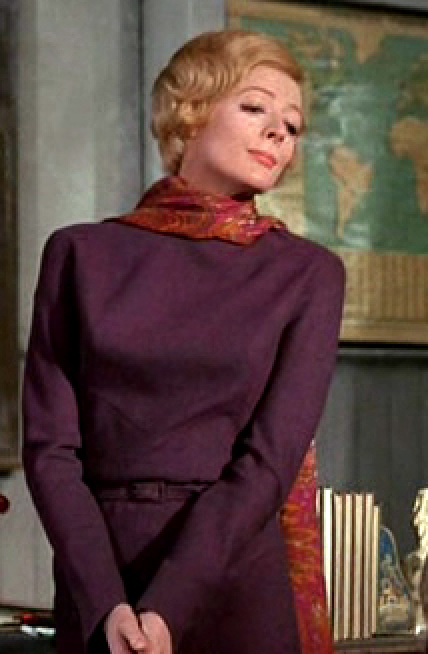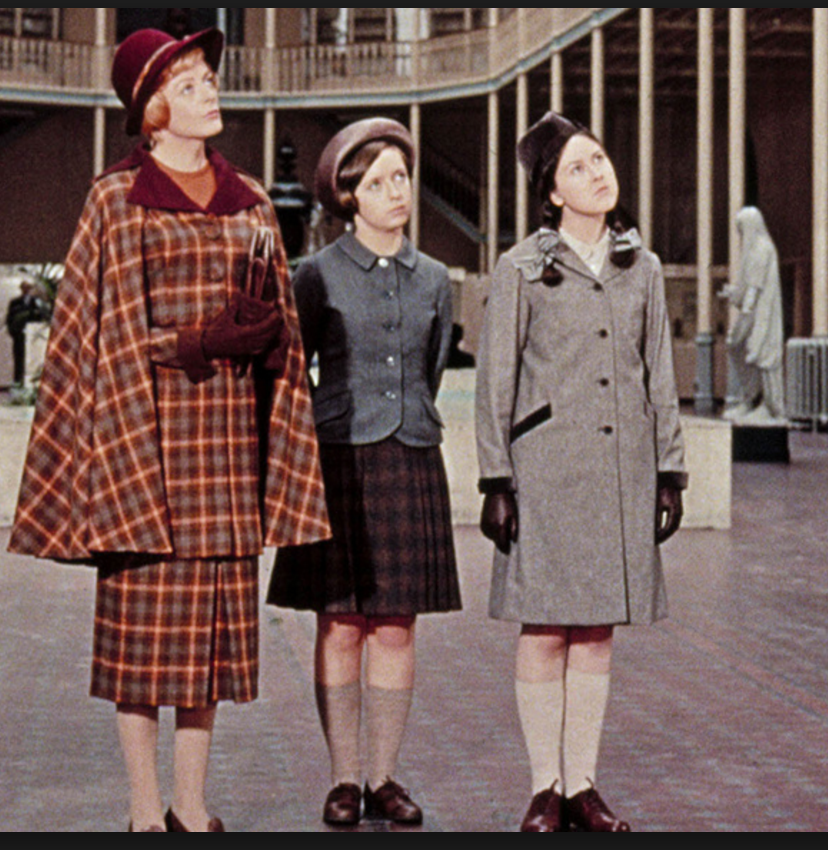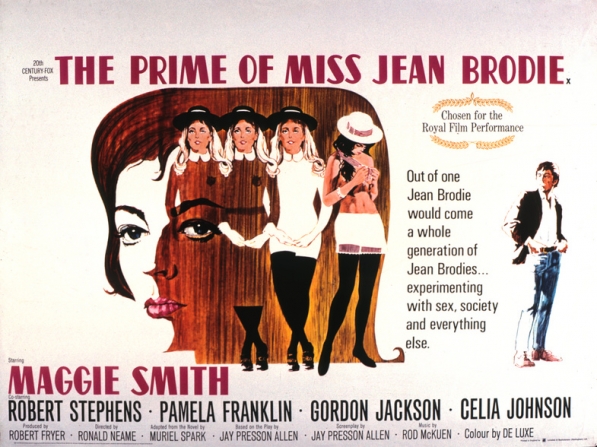 If ever there were a book that wouldn’t be adapted today, it’s The Prime of Miss Jean Brodie. About a 1930s Scottish teacher who pimped out her students to a colleague and favored fascism, it hardly jibes with today’s helicopter parenting and political orthodox–not to mention any ethical compass. Yet it’s arguably Muriel Spark’s best novel and certainly her most touted. As slim as it is crisp – technically, it could be described as a novella – it began its long life as a 1961 segment in The New Yorker before being published as a separate book. In 1968, it was adapted into an eponymous and much-celebrated play by Jay Presson Allen, who went on to write the screenplay for the iconic 1969 film starring Dame Maggie Smith as Miss Jean Brodie. Said Allen: “All the women who played Brodie got whatever prize was going around at that time.” In fact, Zoe Caldwell nabbed a Tony for her portrayal in the theater production, and Smith won a subsequent Oscar.
If ever there were a book that wouldn’t be adapted today, it’s The Prime of Miss Jean Brodie. About a 1930s Scottish teacher who pimped out her students to a colleague and favored fascism, it hardly jibes with today’s helicopter parenting and political orthodox–not to mention any ethical compass. Yet it’s arguably Muriel Spark’s best novel and certainly her most touted. As slim as it is crisp – technically, it could be described as a novella – it began its long life as a 1961 segment in The New Yorker before being published as a separate book. In 1968, it was adapted into an eponymous and much-celebrated play by Jay Presson Allen, who went on to write the screenplay for the iconic 1969 film starring Dame Maggie Smith as Miss Jean Brodie. Said Allen: “All the women who played Brodie got whatever prize was going around at that time.” In fact, Zoe Caldwell nabbed a Tony for her portrayal in the theater production, and Smith won a subsequent Oscar.
These days, you don’t hear the name Maggie Smith without the “Dame” preceding it, and that’s not just out of respect for the honorofic title. Something about the eighty-one-year-old Brit’s regal bearing and perpetual displeasure makes it hard to imagine her as anything but an aristocratic older lady. But in 1969, the thirty-five-year-old Smith was a dame in a different vein–hot enough to summon a femme fatale schoolmarm with panting suitors at her disposal as she misshaped young ladies’ minds. With a dash of the brittle disgust that is her calling card today, the “Downton Abbey” star was the perfect Brodie.
To be clear, “The Prime of Miss Jean Brodie” is hardly a treatise of female liberation. A Google search digs up almost no discussion of Brodie as a feminist (or antifeminist) icon. Yet as embodied by Smith, she offers a fascinating glimpse into a particular strain of twentieth- (and twenty-first) century womanhood. With gimlet eyes, a generous mouth, and a neat figure nipped in by orange and purple sheaths, she stands out brilliantly as she minces down corridors and garden paths in highly insensible pumps. The resident rebel teacher at Edinburgh’s conservative, all-female Marcia Blaine School in the 1930s, she overrides proscribed curricula to trumpet her favorites in that peculiar middle-class accent of trilled Rs and audible italics: the painter Giotto (not Da Vinci!); Benito Mussolini (“romantic, a man of action!”); and a departed lover whose assets she lists in such rhapsodic detail (while absently dismembering a wildflower, no less) that one student bursts into tears. “Monica crrrrries so easily!” she exclaims in scornful surprise.
It’s safe to say Brodie would have a hard time finding a job today, though we believe her when she pronounces, “I’m dedicated to you girrrrls and my prrrime.” At her undeclared age, Miss Brodie pro/claims this personal peak with such regular fervor that it becomes palpable–a Josephina’s coat of many colors, if you will–to her sensory-deprived scholars. And yet, though Brodie doesn’t wear glasses (doesn’t even seem the type to wear glasses), she’s terrifyingly myopic, especially when it comes to the welfare of the teenagers to whom she pledges devotion. It’s not just that she can’t see them outside her needs; it’s that she can’t see herself, as if she is blinded by the dazzling hues she wraps around herself.
For a while her transgressions seem acceptable if eccentric – mostly she plays favorites among her four “Brodie Girls”; takes them on unapproved art outings and picnics; and flaunts her romances with singing master Mr. Lowther (Gordon Jackson) and married art master Mr. Lloyd (rosy-lipped Robert Stephens, Smith’s real-life husband at the time). Eventually, though, she takes things too far, and her charges – pitted against her and each other as erotic rivals –enlist the school’s headmistress already been keen to fire her.
Director Ronald Neame takes too-obvious pleasure in Brodie’s come-uppance, zooming in perilously on her parted mouth and widened eyes as she’s told, “You’re a spinster; you’re dangerous; you’re past your prime, Miss Brodie.” It’s cruel lenswork, consistent with this film’s scrutiny of the fascism and Calvinism – of the sadism and masochism – involved in the molding of young (and older) female minds. The question is whether this ethos is being endorsed or condemned. The visuals are where the story is best told, if still agnostically–especially in the way the girls’ individual facial features only slowly emerge from an institutional blur of grey woolies and black shiny shoes. It’s no wonder Brodie’s bright colors stand out like such a beacon of hope to these young women. When she’s finally reduced to a gray suit with just a piping of mauve, you feel like weeping.
But even when she falls – especially when she falls– you respect the passion with which Brodie grasps for straws,  if not the straws she chooses. For this credit is due both Neame and Smith, who in turn grasp the brutally limited options of a single woman of a certain age. No wonder this schoolmarm develops a predilection for fascism; its starkness, if not palette, mirrors her life.
if not the straws she chooses. For this credit is due both Neame and Smith, who in turn grasp the brutally limited options of a single woman of a certain age. No wonder this schoolmarm develops a predilection for fascism; its starkness, if not palette, mirrors her life.
Spark’s book is preferable to this film, which forgoes her moral flexibility for an unfortunate soundtrack of tremulous violins and Freud-inflected analysis, but this was to be expected. Her smart tonics are preferable to almost everything. Still, “The Prime of Miss Jean Brodie” shines across decades and seas – as a gleaming foreshadow of the “Dead Poets Society”-style cinema trope; as a vehicle for one of the plummier roles ever written for a female actor of a certain age; and as a model of supreme female subversion and sensuality. It’s a violet, violent portrayal.
This originally was published on Signature.
